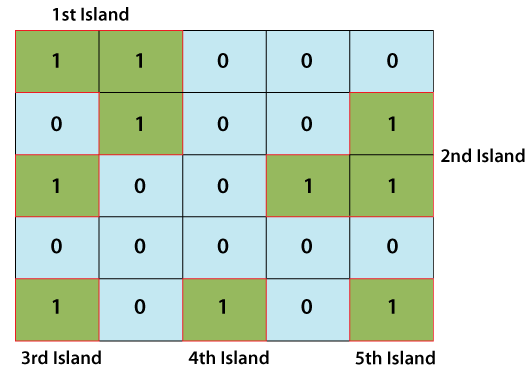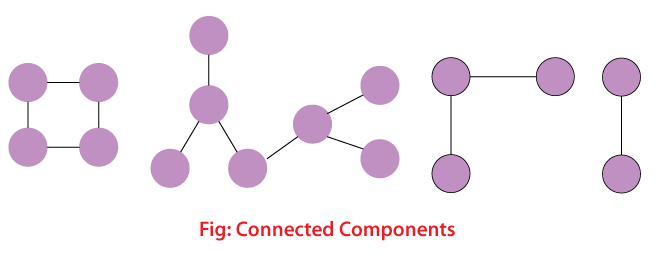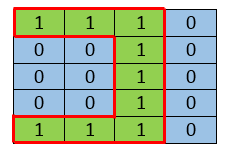Find Number of Island in JavaFinding number of island problem is a standard problem usually asked in top companies coding round interview. The problem is based on the graph theory. In graph theory, we find the number of connected components. In this problem, we have to find the same. So, in this section, we will discuss the island problem statement, algorithm, and Java program to find the number of islands. Problem StatementIn this problem, an island is nothing but a group of connected one's in Boolean 1D, 2D or multidimensional (n-D) array. In this problem, we have to find the number of islands (group of 1's) in a boolean matrix. Note that 1 denotes land. The statement can be rewritten as follows. Given a boolean 2D matrix in which 1's denotes land and 0's denotes water. In this matrix, we have to count the number of islands. An island is a place that is surrounded by water and is formed by connecting adjacent lands horizontally or vertically. Assume all four edges of the grid are all surrounded by water. The following image depicts the same. 
In the above image, the blocks that are highlighted with green color (1's) denotes land and the blocks highlighted with yellow color (0's) denotes water. The above matrix has five islands. The above problem is related to connected component in an undirected graph. So first, we will understand what is connected component. Connected ComponentsA connected component is a graph in which each pair of nodes is connect with each other via path(s) and which is connected to no other vertices outside the subgraph. For example, consider the following graph. 
Example: Consider the following matrix. 
In the above matrix there is only one group of connected 1's. Hence, it denotes only one island. Solution to the ProblemThere are many solutions to the problem. It can be solved either using DFS or BFS. In this section, we will solve the problem using the DFS with recursive and non-recursive approach. Using Depth First Search (DFS)In this approach, we will traverse all the lands (1's) of the matrix one by one. If we found any land untraversed or not visited yet, it means we have to found new islands. Once we visit the island, we will increase the number of islands by 1. Using DFS or BFS, we will mark all the lands which are connected as visited. Algorithm
Java Program to Find Number of IslandsRecursive ApproachIn the following Java program, we have maintained an array named visited. It keeps track of the lands that we have already visited. Define and initialize a variable answer that stores the number of islands. Let's implement the above approach in a Java program. NumberOfIslands.java Output: Number of Islands: 3 Using Non-Recursive ApproachNumberOfIslands.java Output: Number of Islands: 5 ComplexityFor the above problem, the time complexity is O(n*m) because we have visited each element of the grid at least once. Here, n is number of rows and m is number of columns, respectively. The space complexity for the above approach is O(n*m) because we have used a 2D array to store the land whether we have visited or not.
Next TopicBalanced Prime Number in Java
|
 For Videos Join Our Youtube Channel: Join Now
For Videos Join Our Youtube Channel: Join Now
Feedback
- Send your Feedback to [email protected]
Help Others, Please Share










